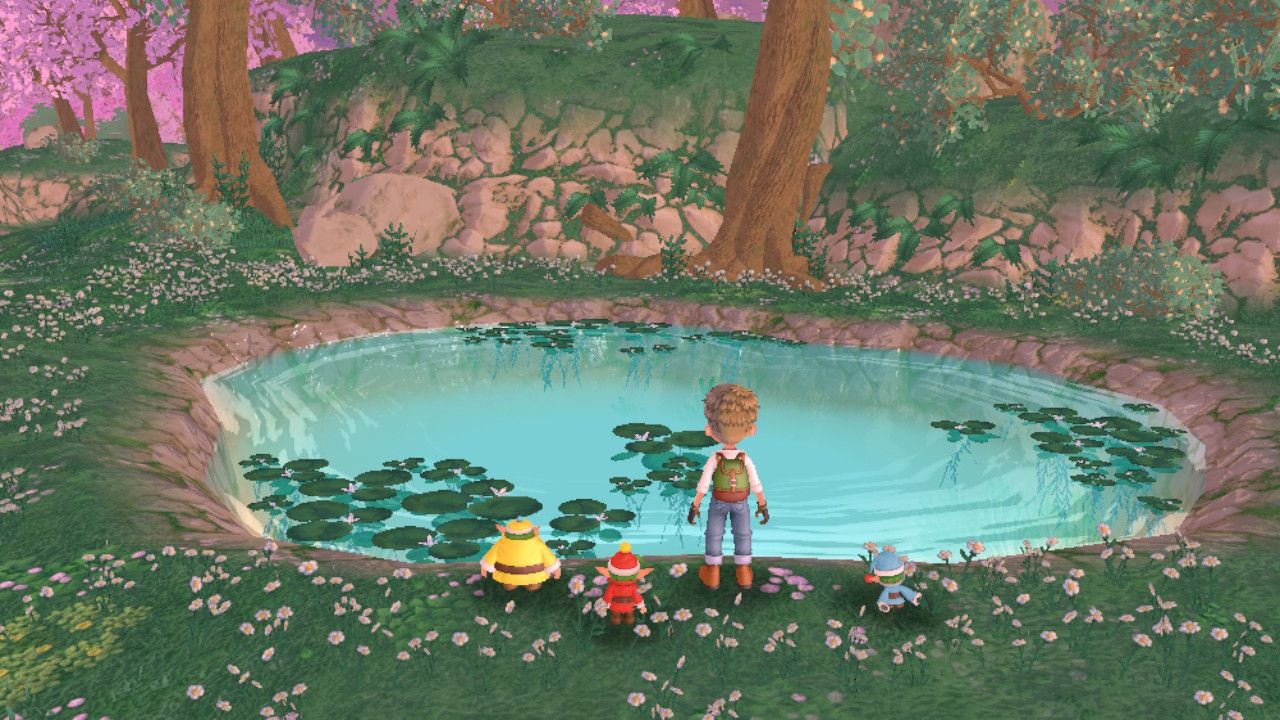Story of Seasons: A Wonderful Life
Cozy farming games are the current hot trend, and it’s somewhat surprising that they have taken so long to become as widely popular as they have. Bokujō Monogatari, known both as Harvest Moon and, more recently, Story of Seasons, has been around since the ’90s. However, while many farming games are still chasing the crumbs left behind by Stardew Valley, Story of Seasons: A Wonderful Life is taking steps to both reclaim the series’ identity and modernise its genre-defining legacy.
Story of Seasons: A Wonderful Life is a remake of the 2003 GameCube game Harvest Moon: A Wonderful Life. For those familiar with the original release, you’ll remember its structure being quite experimental and original. These days we’re used to a standard formula: seasons last 30 in-game days, we have four seasons from Spring through to Winter, each with different available crops, and throughout the year we build relationships with the townsfolk. What A Wonderful Life does differently is condense that timeline yet expands it to last your character’s lifetime. Seasons only last ten days each, so one year is only a quarter longer than your standard season in other Story of Seasons games. However, as story chapters progress and time passes in the game, the residents of Forgotten Valley will age, and their individual stories will unfold. Your job is to decide how you want to live your farming life alongside all these other characters, from whom you befriend to whom you raise a child with.
Aside from your name and pronouns, you can also customise your skin tone, hair colour, hairstyle, and outfit choice.
After our introduction to our inherited farm in the game’s opening cutscene, things may initially seem a little daunting. Luckily, plenty of handy tutorials are accessible from your in-game notebook, and you can read as many or as few of them as needed. The game alerts you to the location of this notebook several times, and is a comparatively filler-free method of explaining how the game works to players who need it. Many in-game tutorials are very hit-and-miss depending on how long they are and if they’re skippable, so this is a happy medium.
You start Story of Seasons: A Wonderful Life with 2000G in your pocket and not much else to your name. Straight off the bat, this gives you some agency: do I start with animals? A cute lil’ chick? A baby cow? Or straight into experimenting with seeds? You’re limited in what you can do at the start of the game, but there’s some nice progression with both animals and farming. For example, while the mechanics are a bit different in this remake, animal breeding is a much more prominent feature than in other Story of Seasons games.
You can’t incubate a chicken egg unless it’s fertilised, and you need both a male and female chicken to start producing fertilised eggs. Just like in real life, male chickens cannot lay eggs, so you’re at the mercy of RNG for whether you hatch a female chicken to increase your egg production. Story of Seasons: A Wonderful Life is the only farming game I’ve ever played where I’ve actually sold animals. Again, just like in real life, men are useless! I jest, but really, if you end up with a coop full of male chickens, that’s not a decision made for the love of money. Sell them!
Raising cows, goats, and sheep is similarly detailed, although some mechanics are simpler than in the original. Female cows no longer need to have given birth before they can start producing milk, goats no longer stop producing milk, and animals, in general, can no longer die. I can see why Marvelous decided to streamline these things, but it does kind of take away from the whole “circle of life” concept that brought such emotional peaks and troughs to the GameCube version.
One final, very welcome update across all animals is that you can now either call them outside or back into their barn or coop simply by ringing a bell placed by their respective doors. It was mildly traumatising in the original game to physically move all your animals indoors and outdoors, especially with how whimsical the weather patterns can be, so this was a great quality-of-life improvement.
We all get performance anxiety from time to time.
Alongside your livestock, you’ll also tend to your crops daily. There’s some nice depth to crop raising, but most of the features are pretty standard for the genre now. Firstly, most crops’ viability isn’t delegated to one season. Your general fruits and veg can usually be grown through two or more seasons, though you can only harvest the produce from your trees in specific seasons. Plants grow through distinct phases, from sprouts to flowering and finally producing their crop. I won’t lie; some of these phases aren’t as visually obvious as I’m used to. I am not ashamed to confess I lost two consecutive batches of turnips because they were ready to harvest and I didn’t notice, causing them to wither and die. Later on, you can also splice plants, leading to some very interesting combinations. I particularly enjoyed a hybrid that looks like a lightbulb during its flowering phase. It’s a very robust system, but you are limited by how much space you have to plant crops.
There are three other activities in Story of Seasons: A Wonderful Life that you’ll need to weave in amongst your farming and social life: fishing, cooking, and digging in the ruins. Fishing is easy, with a simple button tap reeling in your catch when the bobber gets pulled. Other games have much more complex fishing systems, but I saw this as a chance to just chill and enjoy the scenery. Fish are often popular gifts, and you can use them for cooking. Cooking is much more user-friendly in this remake; previously, you’d have to remember every recipe and choose the ingredients individually. Now, you can learn the recipes from townsfolk or harvest sprites. You can still choose to experiment with ingredients, but it’s much more convenient to directly select which recipe to cook.
Digging is another relaxing pastime. The excavation site is a small area divided into a grid, similar to your farmable land. You use a shovel to dig up rare artefacts, golden valuables, and giftable relics. Again, it’s straightforward but does, unfortunately, have perhaps the only aspect of the game that frustrated me. Carter and Flora accompany you in the ruins. They move around a lot, and unfortunately, if they’re standing directly next to the square you’re digging in, the reticule no longer recognises the diggable square, and you have to move somewhere else. It gets even more annoying when you’re reaching the 5:00 pm kick-out time and only have one square left, but Carter decides to have a good old stare at you. If there’s anything I hope gets changed in a post-launch update, it’s this.
Story of Seasons: A Wonderful Life holds up remarkably well for a game that is, at its core, 20 years old. The overarching concept alone is still unique within the genre; no other farming game goes through an entire lifetime. As a remake, it’s very faithful to its source material, which was an excellent direction to take. There are a few minor changes in characters and names, the most obvious being that Forget-Me-Not Valley is now called Forgotten Valley. I always liked the original name, but I do like the irony in the change.
I, Sam-James Gordon, introduce you to Sam, James, and Gordy.
Some characters have been overhauled to become eligible bachelors; the GameCube version only had a male playable character, with three eligible bachelorettes. I was delighted to see Marvelous include same-sex relationships and marriages, as well as pronoun and character customisation options, while bumping up the number of potential spouses to eight. I married Gordy and was glad to see that the skin tone of our magical same-gender-parents baby reflected that one of the dads had a much darker skin tone than the other. Sidenote: naming my character Sam, marrying Gordy, and calling our daughter James was the most self-indulgent naming scheme I’ve followed to date.
You marry your chosen spouse at the end of the first year and chapter, with the second chapter picking up a few years later. It’s not difficult to woo your spouse; I’d maxed Gordy’s relationship towards the end of Autumn without too much trouble. This is where family dynamics start kicking in, as not only will your child continue to grow and develop throughout the game, but you can also influence what career path they’ll choose upon reaching adulthood. Unfortunately, the closest thing to a dance mom I could be was encouraging my child to enjoy art, but this is a farming simulator and not Princess Maker 2, so I shall let it slide.
As time passes, various aspects of life in Forgotten Valley will change. There are some sad moments, which I won’t spoil for you, and you’ll also get some new faces moving in. I’d have liked to see this side of the game developed a little more, but I do also laude it for what it’s accomplished. It feels a bit weird that your character is a very young adult at the start of the game, but an old man by the end, yet the characters who were elderly in the first chapter are just… the same. If Marvelous ever makes another Story of Seasons set across a lifetime, I’d love to see more families organically started throughout the game, and for them to touch on both the sadness and joy that reaching old age can bring. I’ve lost two nans in the past few years, and while it was very sad, there was plenty of beauty to it as well when reflecting on their lives.
You’ll see a brief image of a dream every time you sleep. It’s a charming detail.
Story of Seasons: A Wonderful Life‘s visuals have received the most significant upgrade, with everything from character models to environments receiving a fresh new look. The art style is somewhat different, going from a chibi-style in the previous version to slightly more realistically proportioned body structures in this release. The artists have done a great job capturing the essence of what made the original characters so memorable and translating that into new models. I can imagine some fans will wish they’d done a more 1:1 recreation, but I got a lot of enjoyment from how expressive the characters are and the newly added environmental details. Story of Seasons: A Wonderful Life runs at a solid framerate which, let’s be honest, isn’t usually a selling point of Switch games. There were very few occasions where I felt like the framerate was dipping, and overall everything runs as smooth as freshly churned butter. That’s a farming pun.
As a long-time fan of the Story of Seasons games, I love what Marvelous have done with Story of Seasons: A Wonderful Life. It’s the same game I enjoyed playing all those years ago but with a fresh coat of paint and meaningful quality-of-life updates. The controls and UI are swift and easy to navigate — the amount of time I’ve saved with the new inventory navigation and livestock bells is impressive — and the game feels right at home in the current market. You can tell the development team wanted to preserve what was already an extremely memorable and worthwhile experience, yet understood that gamers’ expectations for accessibility and efficiency are different than they were 20 years ago. There’s already been a flurry of future Story of Seasons games announced, so I hope Marvelous can take some of what made Story of Seasons: A Wonderful Life such a unique experience and bring it forward to their next mainline entry.
Source: RPGFan


